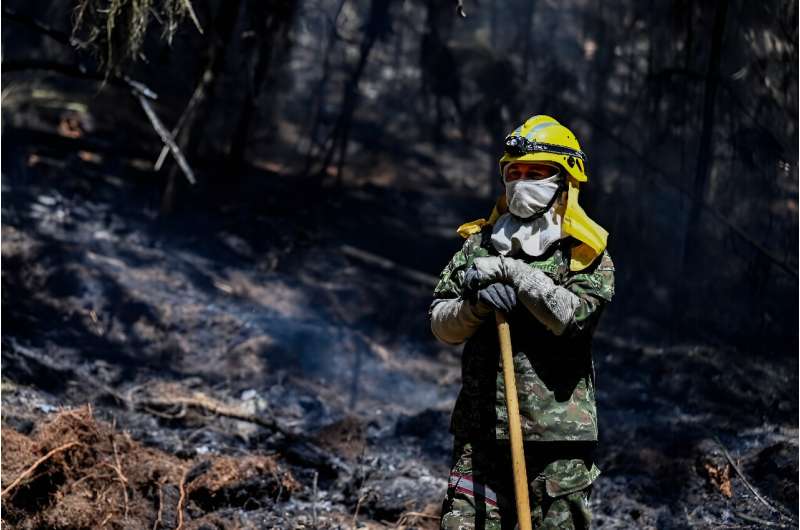This article has been reviewed according to Science X's editorial process and policies. Editors have highlighted the following attributes while ensuring the content's credibility:
fact-checked
reputable news agency
proofread
'The sun didn't sting so much before': fires stun Colombia's Andes

The once bright green Andean forest where Maria Yadira Jimenez worked as a tour guide has been reduced to ashes.
Since Monday, forest fires have been advancing on Nemocon, a rural area with beautiful landscapes about 60 kilometers (37 miles) outside the Colombian capital Bogota.
Though usually cool, the mountains surrounding the town have become a hellscape, with the blazes driving out residents and wildlife.
Distraught, Jimenez joined volunteers who—along with firefighters, rescuers, police and the military—are fighting to extinguish one of the 34 fires that the government has detected in Colombia, which has declared a "natural disaster" amid hot, dry conditions due to the El Niño climate phenomenon.
Fires have razed more than 17,000 hectares (42,000 acres) across Colombia since November, when the drought started and temperatures started to rise, authorities say.
With no experience in emergency response or any fireproof clothing, the volunteers follow in the footsteps of firefighters and use jugs of water to cool areas that have been brought under control.
With picks, shovels and machetes, they stir up the smoldering earth to make sure the fires don't spark back up.
"This is a disaster that is going to bring very serious consequences. Birds were burned, native species were lost and everything was affected," the 46-year-old Jimenez tells AFP.
The area's environmental authority rescued a disoriented fox and an owl from the smoke, but other animals were not so lucky, perishing in the flames.

Sun that stings more
In Bogota, a thick column of smoke rises from the mountain range that edges the city of eight million inhabitants. The sound of helicopters pouring water on the flames echoes all day in the east.
Faced with the "natural disaster" decreed by the government, President Gustavo Petro has sought help from international partners.
The Environment Ministry says at least 20 fires are still active, affecting forests, farmland and the mountain ecosystems that provide water to lower altitudes.
Locals in Nemocon have accused a power company of causing the fire, which spread unchecked among the area's parched pine trees.
When consulted by AFP, the company said the fire was caused by "climatic conditions generated by the heat wave" and that its officials have shut down supply lines that cross the area.
January 2024 is forecast to be the hottest month in Colombia since records began 30 years ago, according to environmental authority Ideam.
"The sun didn't sting so much before," Jimenez explains worriedly.

Francisco Mendoza, 52, loads a pump with water to stop flames from reaching his property.
"We haven't stopped day and night," he says, on the verge of tears, wearing glasses and a mask to protect from the smoke.
"Everyone's property is my property, so when a neighbor is at risk, we are all at risk. We are trying to support each other in that way," he adds.
In Nemocon and Bogota, Indigenous people have been performing rituals asking for rain, but science is not very optimistic.
Ideam anticipates February will be even hotter, and only in March will rainfall alleviate the situation.
For Mendoza, it's a message from nature.
"It is Mother Earth crying for help because we are behaving very badly with her."
© 2024 AFP




















